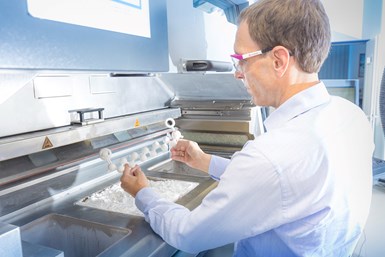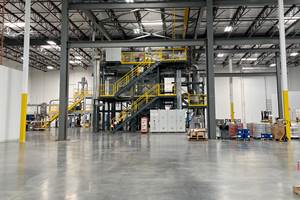Evonik’s PA12 Powder for 3D Printing Based on Biocircular Raw Material
Evonik’s Infinam eCO PA12 is a PA12 powder material for industrial 3D printing that substitutes 100% of fossil feedstock with biocircular raw material from waste cooking oil in a mass balancing process.
Evonik aims to drive the circular plastics economy in additive manufacturing (AM) with its Infinam eCO PA12 material which it says is the world’s first PA12 powder for 3D printing based on biocircular raw material. The specialty chemicals company is introducing this grade of its polyamide 12 powders which is designed to unbound sustainable 3D printing at scale.
Infinam eCO PA12 is a PA12 powder material for industrial 3D printing that substitutes 100% of fossil feedstock with biocircular raw material from waste cooking oil in a mass balancing process. The ready-to-use powder features a 74% reduction of CO2 emissions compared to the castor oil-based polyamides of Evonik's own Infinam Terra development grade.
Having already launched a new PA12 grade with reduced carbon footprint in late 2022, Evonik is now fully aligning its portfolio of polyamide 12 powders with its circularity approach.
The company says true circularity starts with biocircular raw materials. More than 15 million tons of waste cooking oils are produced annually in the world by restaurants, grocers, hotels and casinos, and other food service providers. In addition to other end-of-life possibilities like being processed into biodiesel, waste cooking oil can be used as raw material source for chemical production.
“True circularity is key for being successful in the future. As a pioneer for polymer-based 3D printing materials, Evonik has developed a formula for its PA12 powders to drive circular plastics economy in additive manufacturing,” says Dominic Störkle, head of the Additive Manufacturing Innovation Growth Field at Evonik. “With the introduction of Infinam eCO PA12, we go far beyond chemistry to start closing the loop, and meet the market’s expectations for a better future.”
Infinam eCO PA12 contributes to both footprint and handprint circular values. Besides an improved carbon footprint rate due to renewable energy use for production and biocircular raw material, Evonik says its polyamide 12 grade provides proven reusability rate of 100 % of the structure support powder, with a refresh rate of 70/30 of used versus virgin material over several printing cycles, all the while exhibiting excellent processability and stable mechanical properties of 3D printed parts.
In addition to factors such as production efficiency or reusability of materials, Evonik’s circularity approach includes the total life cycle assessments of its PA12 formulations and their consistent improvement. The specialty chemicals company looks at carbon footprint along with other important factors such as water consumption and land use. By using renewable energy and renewable or recycled feedstocks for production, the group significantly improves the overall eco-balance of its materials. In looking ahead, Evonik is exploring new end-of-life opportunities for PA12 powders to fully close the loop.
The "eCO" description stands for the company's goal of avoiding the greenhouse gas carbon dioxide by using renewable or circular raw materials via the mass balance approach. This method enables an immediate reduction of CO2 in existing plants quality of the products.
Evonik’s 3D printing activities are bundled in the group’s Additive Manufacturing Innovation Growth Field. The strategic focus is on developing and manufacturing industrial, ready-to-use high-performance materials for all major polymer-based 3D-printing technologies. In this way, Evonik aims to drive 3D printing as a large-scale industrial manufacturing technology along the entire value chain. The Additive Manufacturing Innovation Growth Field’s product range is marketed under the new Infinam brand.
- Read about Evonik’s Infinam TPA elastomer powder material for SLS 3d printing. Infinam TPA 4006 P is optimized for SLS technologies, opening up new consumer goods applications.
- Learn about Evonik’s carbon-fiber reinforced peek filament for long-term 3D printed medical implants. The VESTAKEEP carbon-fiber reinforced PEEK filament offers a balance of high strength, ductility and low weight making it a suitable metal-free alternative for implants.
Related Content
Multimodal Powders Bring Uniform Layers, Downstream Benefits for Metal Additive Manufacturing
A blend of particle sizes is the key to Uniformity Labs’ powders for 3D printing. The multimodal materials make greater use of the output from gas atomization while bringing productivity advantages to laser powder bed fusion and, increasingly, binder jetting.
Read MoreVideo: A Mechanical Method for Metal Powder Production
Metal Powder Works has developed a method for producing powders from solid barstock, no melting required. This video covers how the process works and benefits of mechanical production of powders.
Read More3D Printing Brings Sustainability, Accessibility to Glass Manufacturing
Australian startup Maple Glass Printing has developed a process for extruding glass into artwork, lab implements and architectural elements. Along the way, the company has also found more efficient ways of recycling this material.
Read MoreAlquist 3D Looks Toward a Carbon-Sequestering Future with 3D Printed Infrastructure
The Colorado startup aims to reduce the carbon footprint of new buildings, homes and city infrastructure with robotic 3D printing and a specialized geopolymer material.
Read MoreRead Next
Postprocessing Steps and Costs for Metal 3D Printing
When your metal part is done 3D printing, you just pull it out of the machine and start using it, right? Not exactly.
Read MoreAlquist 3D Looks Toward a Carbon-Sequestering Future with 3D Printed Infrastructure
The Colorado startup aims to reduce the carbon footprint of new buildings, homes and city infrastructure with robotic 3D printing and a specialized geopolymer material.
Read MoreProfilometry-Based Indentation Plastometry (PIP) as an Alternative to Standard Tensile Testing
UK-based Plastometrex offers a benchtop testing device utilizing PIP to quickly and easily analyze the yield strength, tensile strength and uniform elongation of samples and even printed parts. The solution is particularly useful for additive manufacturing.
Read More





















